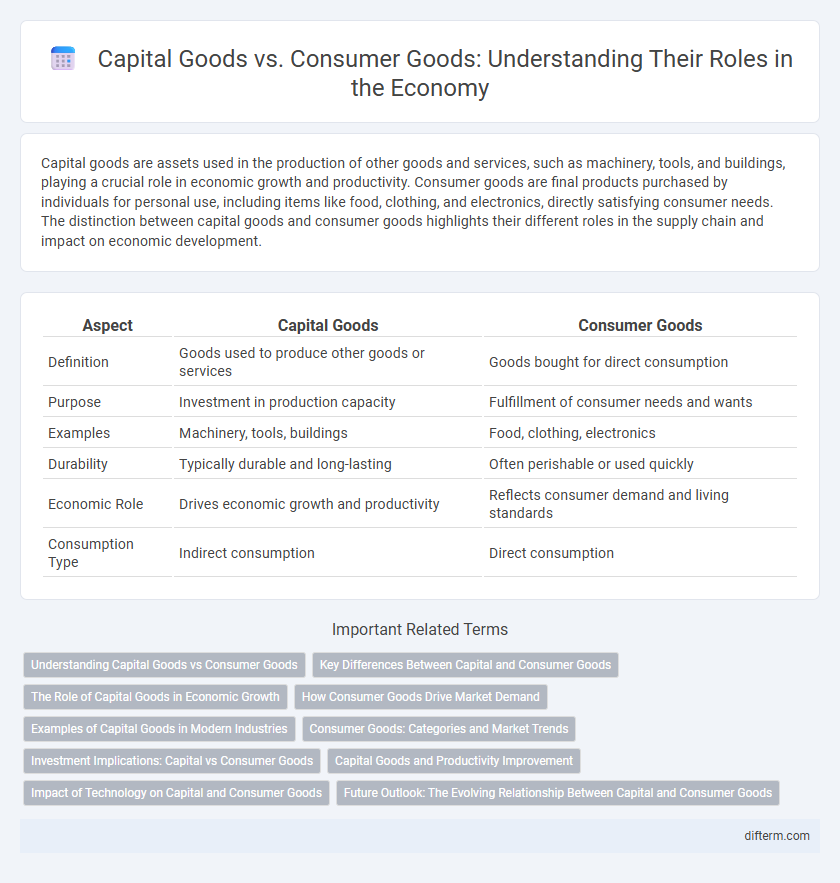Capital goods are assets used in the production of other goods and services, such as machinery, tools, and buildings, playing a crucial role in economic growth and productivity. Consumer goods are final products purchased by individuals for personal use, including items like food, clothing, and electronics, directly satisfying consumer needs. The distinction between capital goods and consumer goods highlights their different roles in the supply chain and impact on economic development.
Table of Comparison
| Aspect | Capital Goods | Consumer Goods |
|---|---|---|
| Definition | Goods used to produce other goods or services | Goods bought for direct consumption |
| Purpose | Investment in production capacity | Fulfillment of consumer needs and wants |
| Examples | Machinery, tools, buildings | Food, clothing, electronics |
| Durability | Typically durable and long-lasting | Often perishable or used quickly |
| Economic Role | Drives economic growth and productivity | Reflects consumer demand and living standards |
| Consumption Type | Indirect consumption | Direct consumption |
Understanding Capital Goods vs Consumer Goods
Capital goods refer to physical assets like machinery, tools, and buildings used in the production of other goods and services, playing a critical role in economic growth and industrial development. Consumer goods are final products intended for direct consumption, including items such as food, clothing, and electronics that satisfy individual needs and wants. Distinguishing capital goods from consumer goods is essential for analyzing investment patterns, production processes, and overall economic efficiency.
Key Differences Between Capital and Consumer Goods
Capital goods are physical assets used in the production of other goods and services, such as machinery, tools, and equipment, whereas consumer goods are final products intended for direct consumption by households. Capital goods contribute to future production capacity and economic growth, while consumer goods satisfy immediate wants and needs. The distinction lies in their purpose: capital goods facilitate production processes, whereas consumer goods fulfill demand for finished products.
The Role of Capital Goods in Economic Growth
Capital goods, including machinery, tools, and equipment, serve as the backbone of economic growth by increasing productive capacity and enhancing efficiency across industries. Investments in capital goods drive innovation, improve labor productivity, and facilitate the expansion of output, leading to higher gross domestic product (GDP). Unlike consumer goods, which satisfy immediate wants, capital goods generate long-term economic benefits by supporting sustainable development and industrial advancement.
How Consumer Goods Drive Market Demand
Consumer goods, encompassing products like electronics, clothing, and food items, directly influence market demand by satisfying immediate consumer needs and preferences. Their rapid turnover and frequent purchase cycles stimulate continuous production and economic activity, contrasting with capital goods that support long-term investment. Consumer spending on goods such as household appliances and personal devices shapes retail trends and drives business strategies aimed at capturing evolving market demands.
Examples of Capital Goods in Modern Industries
Capital goods in modern industries include machinery like CNC machines used in manufacturing, industrial robots employed in assembly lines, and commercial vehicles such as forklifts and delivery trucks essential for logistics. These goods facilitate production processes by enabling efficient operation and increased output capacity. Unlike consumer goods, capital goods are not directly consumed but serve as tools to produce other goods and services.
Consumer Goods: Categories and Market Trends
Consumer goods encompass durable items like electronics and appliances, nondurable goods such as food and clothing, and services including entertainment and personal care. Market trends show a growing preference for sustainable and eco-friendly products, driven by increasing environmental awareness among consumers. E-commerce platforms continue to expand the reach and accessibility of consumer goods, shaping purchasing behaviors across demographics.
Investment Implications: Capital vs Consumer Goods
Investment in capital goods such as machinery and infrastructure drives long-term economic growth by enhancing productive capacity, whereas consumer goods primarily fulfill immediate household needs and do not directly contribute to future production. Higher allocation of resources to capital goods signals a focus on expanding potential output and improving efficiency in the economy. An imbalance favoring consumer goods over capital goods can lead to slower growth and reduced investment returns over time.
Capital Goods and Productivity Improvement
Capital goods, including machinery, tools, and equipment, play a crucial role in enhancing productivity by enabling more efficient production processes and higher output levels. Investment in capital goods leads to technological advancements and economies of scale, driving long-term economic growth. Higher productivity from capital goods reduces production costs and increases the competitiveness of industries in global markets.
Impact of Technology on Capital and Consumer Goods
Advancements in technology have significantly enhanced the efficiency and quality of capital goods by automating production processes and integrating smart machinery, leading to increased industrial productivity and reduced manufacturing costs. Consumer goods benefit from technology through improved product innovation, faster delivery systems, and personalized user experiences driven by data analytics and e-commerce platforms. The symbiotic relationship between technology and goods sectors accelerates economic growth by enabling scalable production of capital goods and fostering dynamic consumer markets.
Future Outlook: The Evolving Relationship Between Capital and Consumer Goods
Technological advancements and automation are reshaping the production of capital goods, leading to increased efficiency and reduced costs that subsequently impact consumer goods availability and pricing. The rise of smart manufacturing and AI-driven supply chains is expected to strengthen the interdependence between capital goods and consumer goods sectors, fostering innovation and rapid market responsiveness. Future economic growth will likely depend on sustained investment in capital goods, as these assets drive productivity improvements that enhance consumer goods variety and quality.
Capital goods vs Consumer goods Infographic

 difterm.com
difterm.com